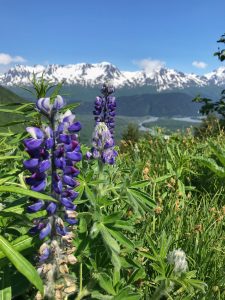
Our friends, Jean and Phil, are about to head out on their first Alaska adventure. I’ve been scouring notes and photos from our own epic time there a couple of years ago, and came across this blog I never published. It brought back a lot of great memories of the unique people, places and experiences that give Alaska its true color. Here’s an intro into a few of the colors of Alaska. Read more.
The colors of Alaska are without question some of the most breathtaking of any natural environment we’d ever experienced. Abundant wildflowers along every trail we hiked. Overflowing baskets of blooms hanging outside shops along Talkeetna’s main street. The greens and browns of stands of spruce, some dying from Spruce Beetle infestation, others still steadfastly reaching to the sky. Blues, greens and browns of the sea, glacier lakes, glacier-fed rivers. Ice-blue glaciers.
But Alaska wouldn’t be complete without the colorful cast of characters that make it their home at least part of the year. In just 14 days there, we got to meet quite a few. Their stories were fascinating insights into the unique journeys that draw and keep people here.
Captain Phil
We pegged Phil as a kayaking guide from a distance as he approached the Talkeenta Railroad Station. Long ponytail, tanned and fit, water sandals and a well-worn, in-need-of-a-wash tee shirt. Yep, that was to be our guide for a day on the Susitna River. Turns out Captain Phil is a pretty smart dude and a well-practiced story teller. Phil spends his summers guiding on these rivers, then heads south – as in FAR south, to Antarctica in the off season where he works as a naturalist on tour boats, leading lectures on penguins and marine life, and otherwise helps out as a deck hand.
As we floated along, hoping to see wildlife – no joy – Phil went from subject to subject with the finesse and insights of a college biology professor. Why are the trees brown? That’s the work of the Spruce Beetle that infests older spruce trees and leads to their eventual demise. The area north of Anchorage and toward Denali seemed to have been hit hard by these nasty insects. Why is the river so murky? That’s the dirt and rock being churned and sent downstream from glaciers. How do people get materials out to the back country to build cabins? The Hurricane Turn Train we’d taken is their lifeline, we learned. Riders use it not only to get themselves to and from their cabins, but they can load lumber, equipment, fuel, supplies onto its cargo car. The train runs every day during summer months, but come winter, residents have little access to civilization.
Over the past few summers, he tells us, he has been building his own off-grid cabin just down the road. Because wild fires are a real thing here (the Talkeetna/Montana Creek area had one just a few weeks after our visit there), he decided his cabin would be built out of river rocks. Phil knows about wildfires; he also is a local volunteer fire fighter. I wondered if he was fighting the July fire, and bet that he was.
So, when we pulled up to a gravelly bank for lunch, Phil spent his break filling our seven-person raft with rocks. It’s going to take a lot of river rocks, and a lot of sweat equity and time, to build his place but he didn’t seem fazed. His home will be small – like most of the cabins in this back country- with no running water or indoor plumbing, and fire as the only source of heat. But his plans for an energy-efficient, wildfire-proof cabin impressed even our homebuilder and electrician on board.
The Dog Sledders
While their friends are taking advantage of a scant few months of warmer Alaska weather and super long days of sunlight before the winter returns dark and cold, a small group of hearty souls choose to live with a bunch of dogs up on Punchbowl Glacier. The lone two females had arrived on the glacier just a day before we did, and the newbies had been relegated to scooping the poop that day so we didn’t get much conversation with them. But some of these kids and dogs are pretty experienced on this glacier and others. Our musher Ryan Santiago ran the Iditarod in 2019, finishing 29th in 12 days, five hours and change. Ryan made his way to Alaska via California, Austin, Nepal and New Zealand.
Our lead dog was a near-finisher, getting to 980 miles before having to stop. So close. But on this 3-kilometer track, he gets to be a finisher several times every day all summer long. The photographer working on the mountain happened to mention to a group last summer that he was a big tennis player. That got him an invite from some Australian tourists to come live with them and work the Australian Open – so he decided college could wait, and off he want to Australia. Coming back to Texas heat with us didn’t seem like much of an offer, so we just said good bye.
Alaska Taxi Driver
Well, actually, it was a water taxi driver. After a morning of sea kayaking in Petersen Bay across from Homer, the kayak guide had prearranged for a water taxi to pick us up for transport to a trail head for afternoon hiking. Let’s just say this “vintage” taxi had seen some days on the water. As we putted away from the dock, silently, we were thinking about those horror movies in which a slightly weird boat driver on a somewhat scary looking vehicle takes his passengers on a ride to nowhere if you know what I mean.
But not to worry – he delivered us, and returned later to take us to the infamous Saltry Restaurant on Halibut Cove, where we were to have dinner and catch a different ride home. Before pulling up to the Saltry dock, however, he putt-putted his little rig through the cove for a visual of these beautiful and remote homes. These are no Captain Phil off-grid rock cabins. This looks to be some expensive real estate (and just for the record, our meal at the Saltry – while delicious – was by far the priciest of the trip).
As we rounded the last bend, he points to perhaps one of the most impressive of them, a gorgeous cliff-side home with dock below and says, “That’s my house.” Wait, what? I think we did a good job of covering our collective gasps, and pulling our chins back up before he saw us. But, how could this water-worn guy in this weather-worn skiff own that? Apparently, it turns out, in his past life he was a home builder and must have been a pretty successful one at that. And now he drives a water taxi. Sounds like a pretty good trade off.
Ann the Ranger
Our group of six hikers – which started out thinking OK, this is just a “moderately difficult” trail, piece of cake –was now sweating and breathing heavily as we rounded yet another switchback headed up a steeply ascending Marmot Meadows trail toward Exit Glacier. So seeing an older woman coming downhill toward us presented a welcome opportunity to take a break for a moment. We stepped to the side of the trail to let her pass, and as she did, we asked her some combination of “are we there yet?” and “how much farther?” We did notice that she wasn’t even breathing hard, yet looked to be maybe late 70s. Her Park Service badge told us this was Ann. Ann and her husband have been working in the Kenai Fjords National Park for 15 years now. Her husband was “somewhere farther down in the park” she motioned nonchalantly. No, she hadn’t seen any bear today but a few days ago, yes, a bit further up on this trail. Not only is she 70s and clearly hiking these trails with ease, but she’s doing so alone in BEAR COUNTRY. This right there, folks, is an Alaska woman.
They both worked in this park years back alongside our new friend Ryan (next story), whom she hadn’t seen in years. To happen to be on the same trail at the same precise moment on the same day – was it karma, destiny, small world or seven degrees of separation? Or just another cool Alaska encounter? As she sent her regards to Ryan and cheerfully assured us “you are almost there” and “it’s worth it,” Ann disappeared down the trail and around the bend out of sight.
A Texan in Paradise
We met Ryan R at dinner our first night in Seward. The Ryan in our travel party had known this Ryan since their school days together in Texas. Ryan R fell in love with Seward so much that he moved here full time years ago, and that’s when he worked in the park (with Ann and her husband). An educator, he landed a job in the local library too. It’s tough to eke out a living in Alaska, especially in the long, dark winters when tourism shuts down. But Ryan eventually purchased a piece of property and over the last 9 years has built an off-grid cabin with the help of lots of friends (like our travel partner Ryan) and family. A few years back, Ryan and his fiancé got married in a small church in downtown Seward. Their cabin is now on VRBO and the week after we all left Seward, they were moving with their newborn to Africa for her medical residency program. Just another adventure opportunity too good to miss.
There are so many other interesting characters that made our Alaska trip special. The 20-something female bartender in Talkeetna who moved here on a whim (someone said it was a nice place). The float plane pilot in Homer who traded a commercial aviation career for the uncertain but enticing opportunity of his dream job. The kayak guide, who normally spends the off season on ski patrol in Colorado, but this year heads to New Zealand, finally scoring a tourist visa after years of waiting. The crusty gal working the check-in desk at Montana Creek Campground who apparently thought anyone from Texas was city folk. And, frankly, maybe we are.
What we found in Alaska were people with grit and determination, fearless and adventuresome, and who are living their lives to their fullest, on their terms. My kind of people.



Blog / November 13, 2023
Magnificent Moab: Southeast Utah's Mecca for Outdoor Adventure